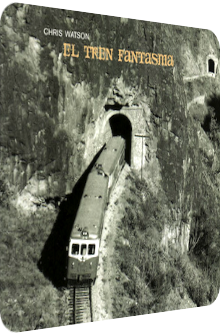
Chris Watson
El Tren Fantasma
2011
Eight years after his successful field recording album Weather Report, Chris Watson comes up with another masterful record that would be in a league of its own if such a league existed. The source material of El Tren Fantasma, however, is actually older than the three condensed aural landscapes of Weather Report, as it harks back to the year 1999 when Watson was able to take the last Mexican train ever from Los Mochis to Veracruz which finished this route. The artistic and aesthetic values are thus easy to grasp: this album takes the listener back to a route that is shut down for over a decade now and cannot be easily accessed anymore – yet the memories that consist of various sounds and spaces live on in the form of Watson's album. While Weather Report focused solely on the beauty and harsh powers of nature, Watson reunites it with the counterpart, technology. From travel-related service announcements over echoey tunnel rumblings to the clanging metallic sounds of the train, this album is a dream come true for train supervisors as well as people interested in this field. All 10 tracks depict the attributes of the respective intermediate stations in condensed form. As usual, Watson didn't just pull out his field recording device and started recording, but in fact captures the atmosphere, the pulsating life, the oddities and variations of both technological and nature-related noises. Since this album has to be experienced, the middle section of this review might be slightly shorter than usual, but I will describe the overall qualities and specialties of each area regardless.
La Anunciante begins with blurry wind-like noises, but soon morphs into the well-known noise of a fast train that stops slowly. A Mexican lady makes a few announcements and is the sole organic ingredient of an otherwise completely train-focused track. The different noises, tone pitches and flowing sounds, however, show that this supposedly cold beginning is actually full of warmth and vibrant energy. Train afficionados will surely agree. Los Mochis paints a completely different aura with screaming roosters, chirping birds, barking dogs and distant Folk songs on a guitar. When the train departs screechingly, the frizzles and hisses throw the listener out of this cozy warmth. However, soon mumbling noises, joyful children and walkie talkie messages can be heard. As stated before, Watson compresses the hour-long timespan of a destination into minutes, an approach he already used on Weather Report. The following Sierra Tarahumara offers particularly vivid birds, streaming water, buzzing bumblebees and far away train signals which are the only reminders of the technological focus, while El Divisadero is a field recording taken on the train that actually turns into a rhythmical percussive track: the train signal becomes blurry, a rumbling drone sound is exchanged with the incessant clangs of the rails which are then looped and merged with beats, reminding of a track that Burial and other Dubstep producers could have come up with. Anyway, this dark and menacing tune adds a third layer to the already introduced entities of technology and nature: music. Crucero La Joya features more insect-filled fields and steppes and is completely detached from any train-related sound. Chihuaha, on the other hand, starts with mechanical bursts and rumblings but adds gloomy synth washes near the end of its runtime. Aguascalientes presents gentle ocean waves and motorboats plus warm winds, and Mexico D. F., an 8+ minute long vignette delivers various railway and train noises that are especially placid and deep. The train enters the station, Watson adds another percussive element of enormously deep, pumping beats while the ghost train continues its journey to El Tajin, a 10+ minute long centerpiece that inherits the flavor from Weather Report by presenting the unison of nature with deep wind noises that could also be artificial drones. The final Veracruz ends the journey on a majestic note with a hugely dynamic hodgepodge of various railway noises and train signals that sound like pompously proud brass sections.
Chris Watson delivers yet another field recording that already conveys his concept to the listeners on the front cover that shows a photo taken by Jon Wozencraft. And sure enough can the saying "What you see is what you get" be applied here. Since the listener knows beforehand what to expect, there's little room for surprises. And yet Watson comes up with two non-expected features: for one, the music-related ingredients such as the percussive railway loops on El Divisadero and the red, dusky synth setups on Chihuahua remind of Watson's ethereal Ambient album Cima Verde where these elements are featured boldly. Secondly, experts of Watson's recordings know about the plasticity and vibrance of his material. And yet the sound quality knocked me off my feet on higher volume levels when the steam is frizzling and the rails are clattering all the better and more intimidating than I thought. Intertwining nature with technology is a common theme, but it has never been delivered this successful in a field recording. The journey aspect plays another important role. The listener is able to experience a route that doesn't exist anymore, making this record a device that fulfills both melancholic memories and the needs of tech and train fans. I prefer Watson's Weather Report due to its aquatic and glacial beauty, but El Tren Fantasma offers more action, an interesting unison of diverse elements and, best of all, more of the same careful setups that are linked to Watson's name. Is this an Ambient album or even an Exotica album? Yes, in parts. The nature sections are tranquilizing and the locations that Watson was passing by are now more exotic than ever. Once the listener-related nostalgia sets in, this can be considered an Exotica album as well. But why should we focus on such categorizations? It's a stunning album, it's real, the sound quality is top notch and the aesthetic value sky-high.
Ambient Review 054: Chris Watson – El Tren Fantasma (2011). Originally published on Apr. 4, 2012 at AmbientExotica.com.
